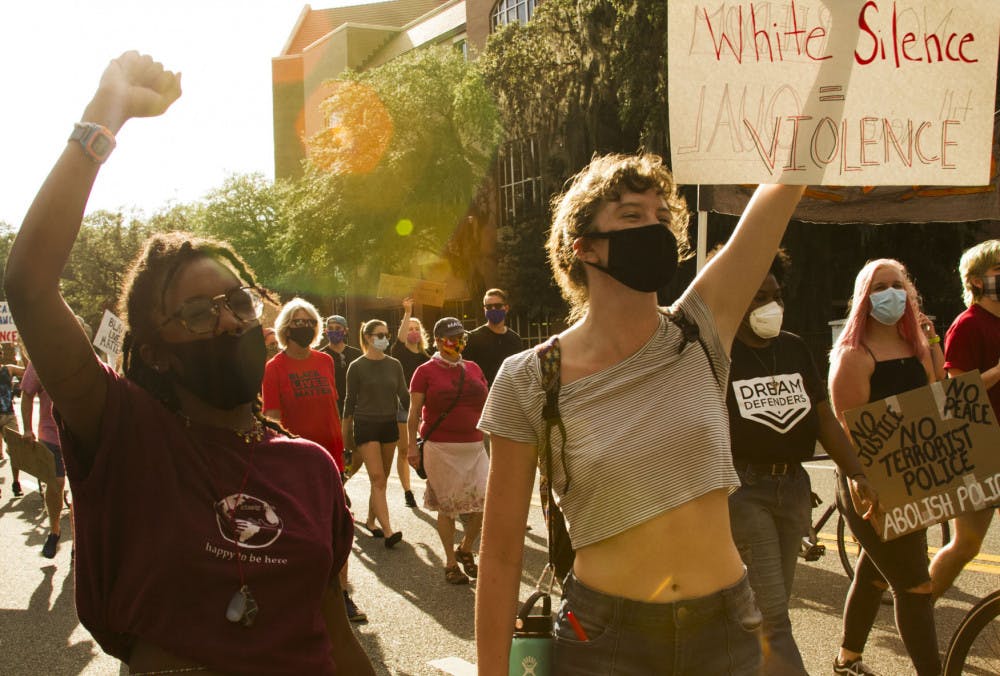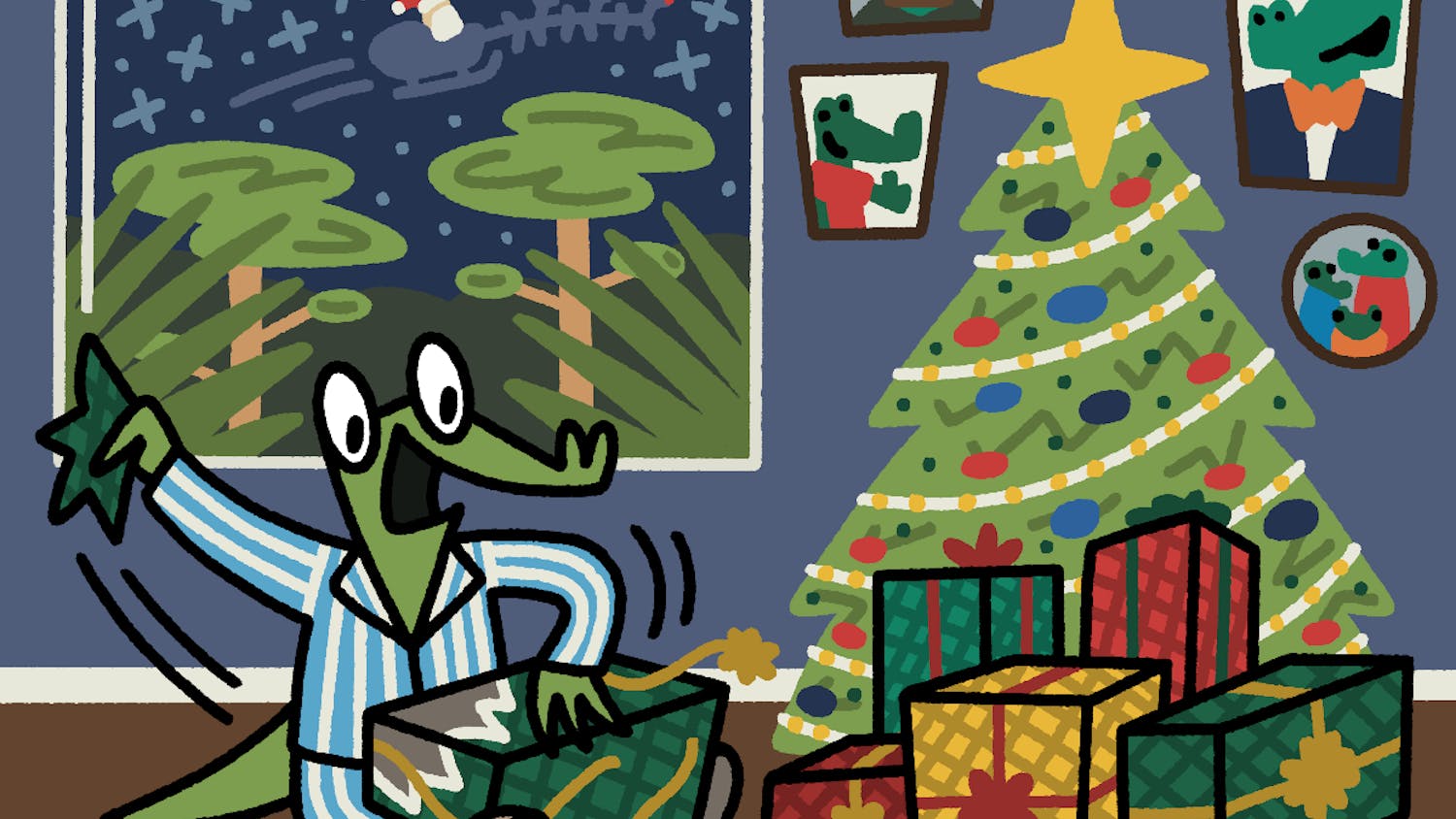A family of three stood together in a tight circle. Trenita White held an umbrella while her daughters, Joanna and Juanita, passed back and forth a cardboard sign that read “Black Lives Matter.” It ended at Joanna, who held it for the majority of the march.
As minutes passed, the women quieted. They peered into the center of the crowd where a group of organizers prepared to speak.
“I want to march already,” said the younger sister, Juanita, an 18-year-old UF business management freshman.
Soon, they would.
Almost 1,500 others marched Saturday evening in protest of police violence and systemic racism. Protesters blocked sidewalks and intersections and listened as organizers illustrated how decades of gentrification and inequality impact the experience of Black people in Gainesville today.
The protest began in front of the O’Connell Center.
O’Connell Center, 6:10 p.m.
“Stephen C. O’Connell was a racist,” said Alexandra St Tellien, a member of the GoDDsville Dream Defenders. O’Connell was the president of UF from 1967 to 1973, too.
St Tellien told the story of Black Thursday, when members of the Black Student Union held a sit-in at the UF president’s office on April 15, 1971, to demand a Black cultural center on campus and other programs to improve the lives of Black UF students.
Sixty-six protesters were arrested, 60 of whom were put on academic probation. O’Connell denied the arrested students amnesty, saying that doing so “would be admitting that the sit-in in my office was proper conduct now and in the future,” according to an article in Alternative UF, a 2009 exhibition created by undergraduate students focusing on campus activism at UF.
“UF speaks about diversity, but having these monuments is kind of contradicting themselves,” Juanita said.
She grabbed her sister’s shirt sleeve and pulled as the crowd made its way to the next stop.
University Avenue and 13th Street, 6:50 p.m.
In the center of the intersection, Wallace Mazon, a 25-year-old UF alumnus and Dream Defenders member, asked protesters to kneel for 9 minutes of silence—about the amount of time former Minneapolis police officer Derek Chauvin knelt on George Floyd’s neck.
During the silence, three young Black men wearing hoodies lay face down on the pavement. They held their hands together behind their backs, simulating being constrained by handcuffs.
All three chanted, “I can't breathe,” at each minute interval of the moment of silence.
Nine minutes later, the crowd got to their feet. Juanita and Joanna helped their mother off the asphalt and followed the procession north down 13th Street. The chants continued.
A. Quinn Jones Museum and Cultural Center, 7:20 p.m.
The Whites dodged anthills and swatted bugs from their ankles as they arrived at the march’s third stop. They stood on the grass in front of the museum to listen.
Pleasant Street, which includes the area between Northwest Second and Eighth Avenue and Northwest First and Sixth Street, was first developed during reconstruction after the Civil War by families of freed slaves.
The area is being impacted by gentrification and outside developers, said Danielle Chanzes, a volunteer for the Gainesville Alliance for Equitable Development.
She told the story of Seminary Lane apartments, a former complex on Pleasant Street that was demolished in 2009. Hundreds of Black residents were promised that affordable housing would take its place—it didn’t. Nothing has replaced it in the 11 years since it was torn down, she said.
Juanita and Joanna’s mother, Trenita, nodded during the speech.
“I’ve been in Gainesville since 1981, so I can see the difference,” she said. “It’s not the same.”
After Chanzes finished, Mazon rallied the crowd to continue.
“For those of you who know this neighborhood, you know where we are going next,” he said.
Gainesville Police Department, 8 p.m.
“Who are you protecting? Who are you protecting?”
The words echoed down Northwest Sixth Street as protesters neared the Gainesville Police Department on 545 NW Eighth Ave.
There, Mazon announced a list of demands that the GoDDsville Dream Defenders will present to local government officials. Joanna and her sister cheered after each.
Require anti-racism accreditation for Gainesville city and county commissioners, he said. Divert police funding to community-based programs like mental health clinics. Remove or rename all buildings, statues or monuments in the county named after Confederates, like J.J. Finley Elementary School. Teach more Black history in schools.
Mazon added that demonstrations will be organized outside city and county commissioner’s offices and homes until changes are made. Mazon asked the protestors to raise their hands in the air, make a fist and repeat after him: “No justice, no peace. There’s no such thing as a peaceful uprising. We are not violent. Peace will not bring forth life and liberation for all.”
Alachua County Courthouse, 8:45 p.m.
On their way to the Alachua County Courthouse, the protesters were met with jeers.
One man yelled, “I hate you!”
Jhody Polk, the founder of the Legal Empowerment and Advocacy Hub, spoke from the steps of the courthouse about corruption and inequality within the justice system and her fears as the mother of a Black son.
“Every time my son goes outside, I can’t breathe,” she said.
Joanna’s friend, Kiara Cubo, 22, said said she didn’t know much about the court systems. Instead she relies on Joanna, who is studying to become a lawyer, to keep her informed on what’s important.
“It’ll be nice if there’s more representation in the court, such as for the Black community or other minorities, so that the rules that are made are beneficial for all people, not just one major group,” said Cubo.
Porters Community, 9:30 p.m.
Late in the evening, the crowd thinned by almost half. A few counter-protesters joined to heckle, only to be booed by those who remained.
Porters Community is the second oldest Black community in Gainesville and the last stop for protesters.
Mazon told the crowd that the edges of the neighborhood are being bought and developed into student housing––displacing the families that have lived there since its 1884 founding. Peaceful protests are necessary to protect communities like Porters and Pleasant Street and their inhabitants, he added.
“We are on the right side of history, and don’t let anyone tell you otherwise,” Mazon said. “We are going to continue to be in these streets.”
Trenita and her daughters shifted their weight from one foot to another as the march drew to a close. It had been a long walk.
In a matter of minutes, the crowd dispersed. The sky was dark, and it had been raining. St Tellien stayed behind to chat with other organizers and make sure protesters had a way back.
“People are fed up with white supremacy, people are fed up with the injustice in our system,” she said. “We’re saying no more, and we want change.”
Contact Kaelyn and Tristan at kcassidy@alligator.org and twood@alligator.org. Follow them on Twitter @kaelyn_cassidy and @TristanDWood.






